线程池的核心目的就是资源的利用,避免重复创建线程带来的资源消耗。因此引入一个池化技术的思想,避免重复创建、销毁带来的性能开销。
Table of contents
Open Table of contents
手写一个线程池
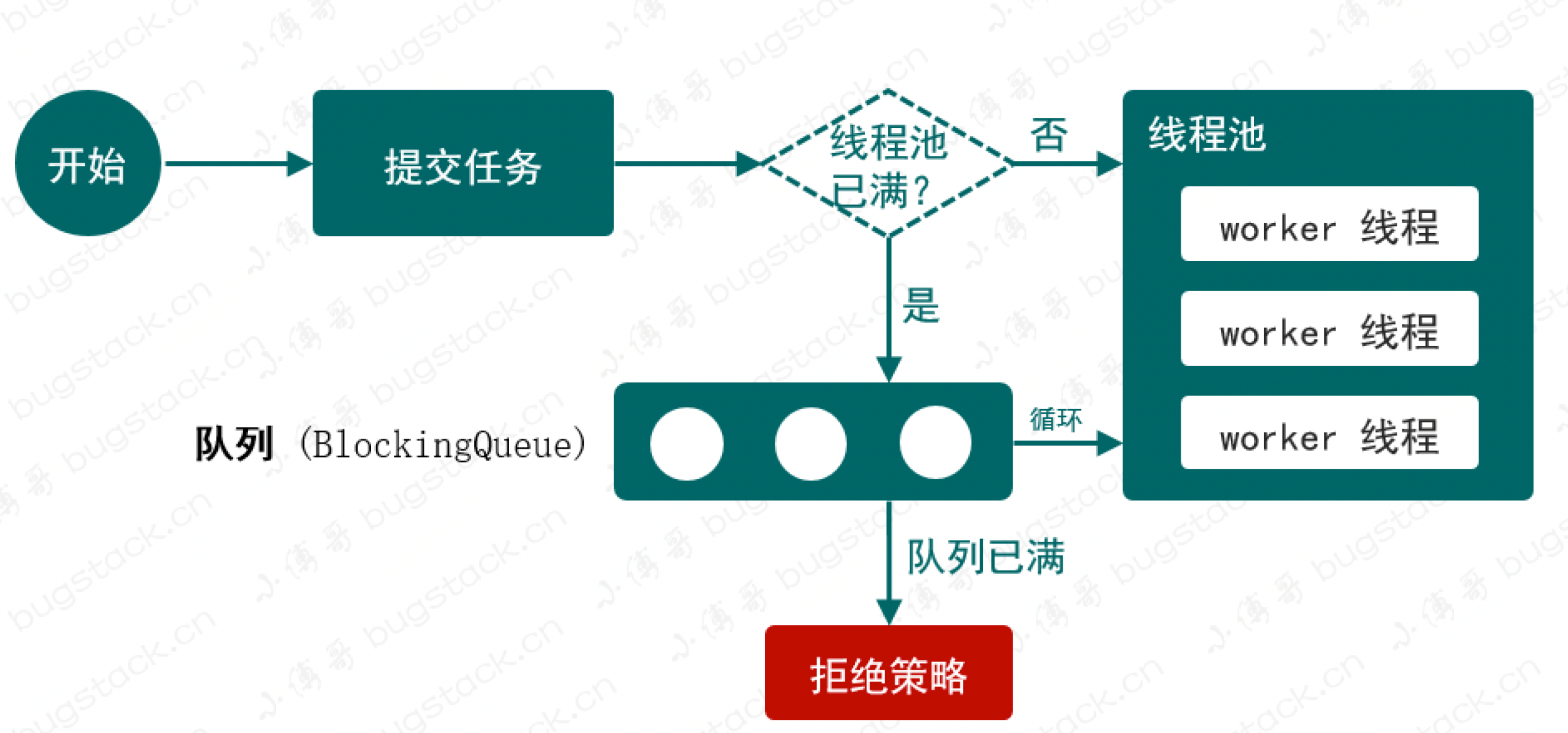
这个手写线程池的实现也非常简单,只会体现出核心流程,包括:
- 有 n 个一直在运行的线程,相当于我们创建线程池时允许的线程池大小。
- 把线程提交给线程池运行。
- 如果运行线程池已满,则把线程放入队列中。
- 最后当有空闲时,则获取队列中线程进行运行。
import java.util.concurrent.ArrayBlockingQueue;
import java.util.concurrent.BlockingQueue;
import java.util.concurrent.Executor;
import java.util.concurrent.atomic.AtomicInteger;
public class ThreadPoolTrader implements Executor {
private final AtomicInteger ctl = new AtomicInteger(0);
private volatile int corePoolSize;
private volatile int maximumPoolSize;
private final BlockingQueue<Runnable> workQueue;
public ThreadPoolTrader(int corePoolSize, int maximumPoolSize, BlockingQueue<Runnable> workQueue) {
this.corePoolSize = corePoolSize;
this.maximumPoolSize = maximumPoolSize;
this.workQueue = workQueue;
}
@Override
public void execute(Runnable command) {
int c = ctl.get();
if (c < corePoolSize) {
if (!addWorker(command)) {
reject();
}
return;
}
if (!workQueue.offer(command)) {
if (!addWorker(command)) {
reject();
}
}
}
private boolean addWorker(Runnable firstTask) {
if (ctl.get() >= maximumPoolSize) return false;
Worker worker = new Worker(firstTask);
worker.thread.start();
ctl.incrementAndGet();
return true;
}
private final class Worker implements Runnable {
final Thread thread;
Runnable firstTask;
public Worker(Runnable firstTask) {
this.thread = new Thread(this);
this.firstTask = firstTask;
}
@Override
public void run() {
Runnable task = firstTask;
try {
while (task != null || (task = getTask()) != null) {
task.run();
if (ctl.get() > maximumPoolSize) {
break;
}
task = null;
}
} finally {
ctl.decrementAndGet();
}
}
private Runnable getTask() {
for (; ; ) {
try {
System.out.println("WorkQueue.size:" + workQueue.size());
return workQueue.take();
} catch (InterruptedException e) {
e.printStackTrace();
}
}
}
}
private void reject() {
throw new RuntimeException("Error! ctl.count:" + ctl.get() + " WorkerQueue.size:" + workQueue.size());
}
public static void main(String[] args) {
ThreadPoolTrader threadPoolTrader = new ThreadPoolTrader(2, 2, new ArrayBlockingQueue<>(10));
for (int i = 0; i < 10; i++) {
int finalI = i;
threadPoolTrader.execute(() -> {
try {
Thread.sleep(1500);
} catch (InterruptedException e) {
e.printStackTrace();
}
System.out.println("任务编号:" + finalI);
});
}
}
}
主要功能逻辑包括:
- ctl ,用于记录线程池中线程数量。
- corePoolSize 、 maximumPoolSize ,用于限制线程池容量。
- workQueue ,线程池队列,也就是那些还不能被及时运行的线程,会被装入到这 个队列中。
- execute ,用于提交线程,这个是通用的接口方法。在这个方法里主要实现的就 是,当前提交的线程是加入到 worker 、队列还是放弃。
- addWorker ,主要是类 Worker 的具体操作,创建并执行线程。这里还包括了 getTask() 方法,也就是从队列中不断的获取未被执行的线程。
这个代码有很多问题没有考虑,如线程池状态呢,不可能一直奔跑呀!?、线程池的锁呢,不会有并发问题吗?、线程池拒绝后的策略呢?,这些问题都没有在主流程解决,也正因为没有这些流程,所以上面的代码才更容易理解。
Java 自带线程池(ThreadPoolExecutor)
类图
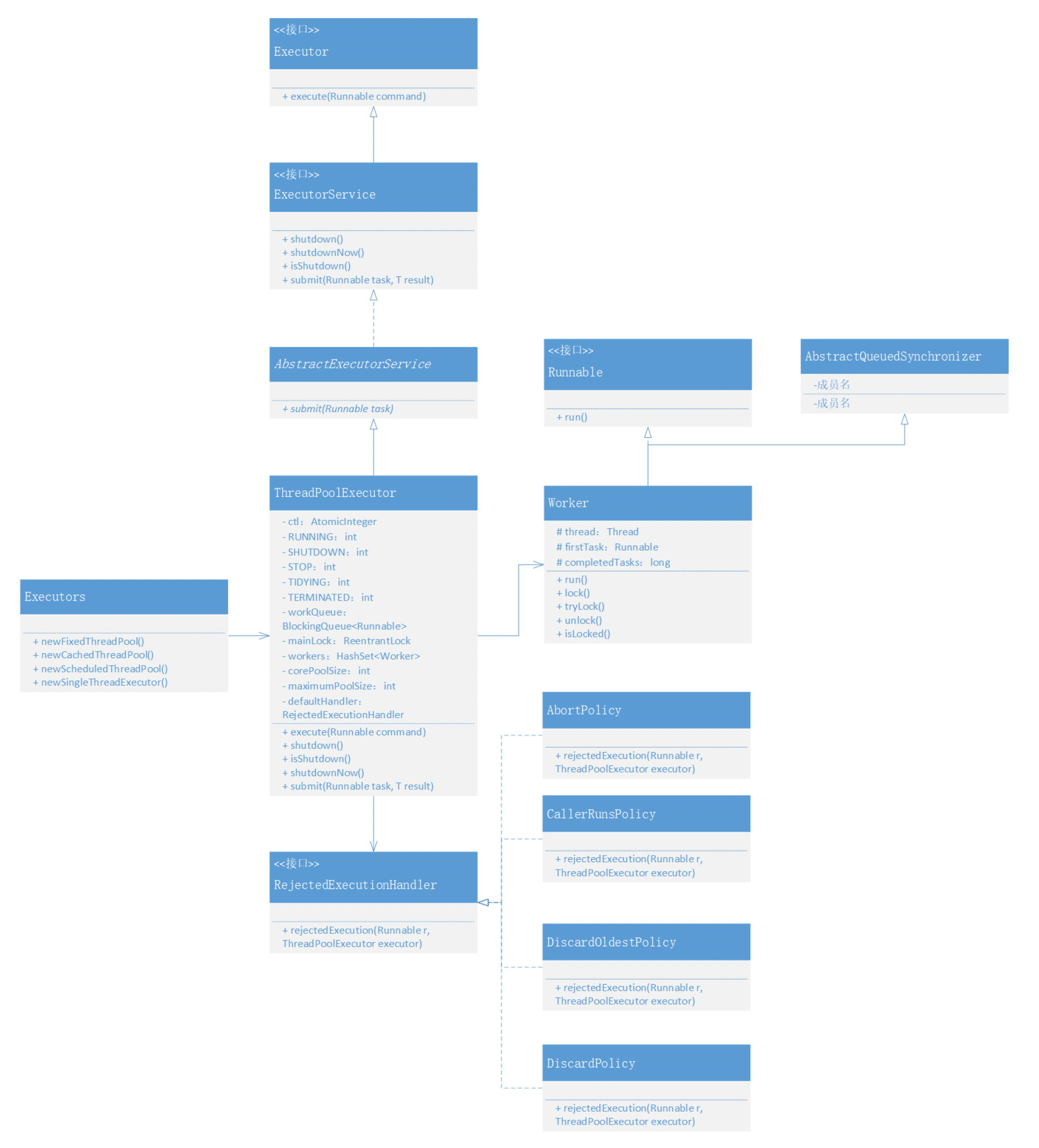
以围绕核心类 ThreadPoolExecutor 的实现展开的类之间实现和继承关系。
- 接口 Executor 、 ExecutorService ,定义线程池的基本方法。尤其是 execute(Runnable command) 提交线程池方法。
- 抽象类 AbstractExecutorService ,实现了基本通用的接口方法。
- ThreadPoolExecutor ,是整个线程池最核心的工具类方法,所有的其他类和 接口,为围绕这个类来提供各自的功能。
- Worker ,是任务类,也就是最终执行的线程的方法。
- RejectedExecutionHandler ,是拒绝策略接口,有四个实现类 AbortPolicy( 抛异常方式拒绝 、 DiscardPolicy( 直接丢弃 、 DiscardOldestPolicy( 丢弃存活时间最长的任务 、 CallerRunsPolicy( 谁提交谁执行 。
- Executors ,是用于创建我们常用的不同策略的线程池 newFixedThreadPool 、 newCachedThreadPool 、 newScheduledThreadPool 、 newSingleThreadExecutor 。
线程状态
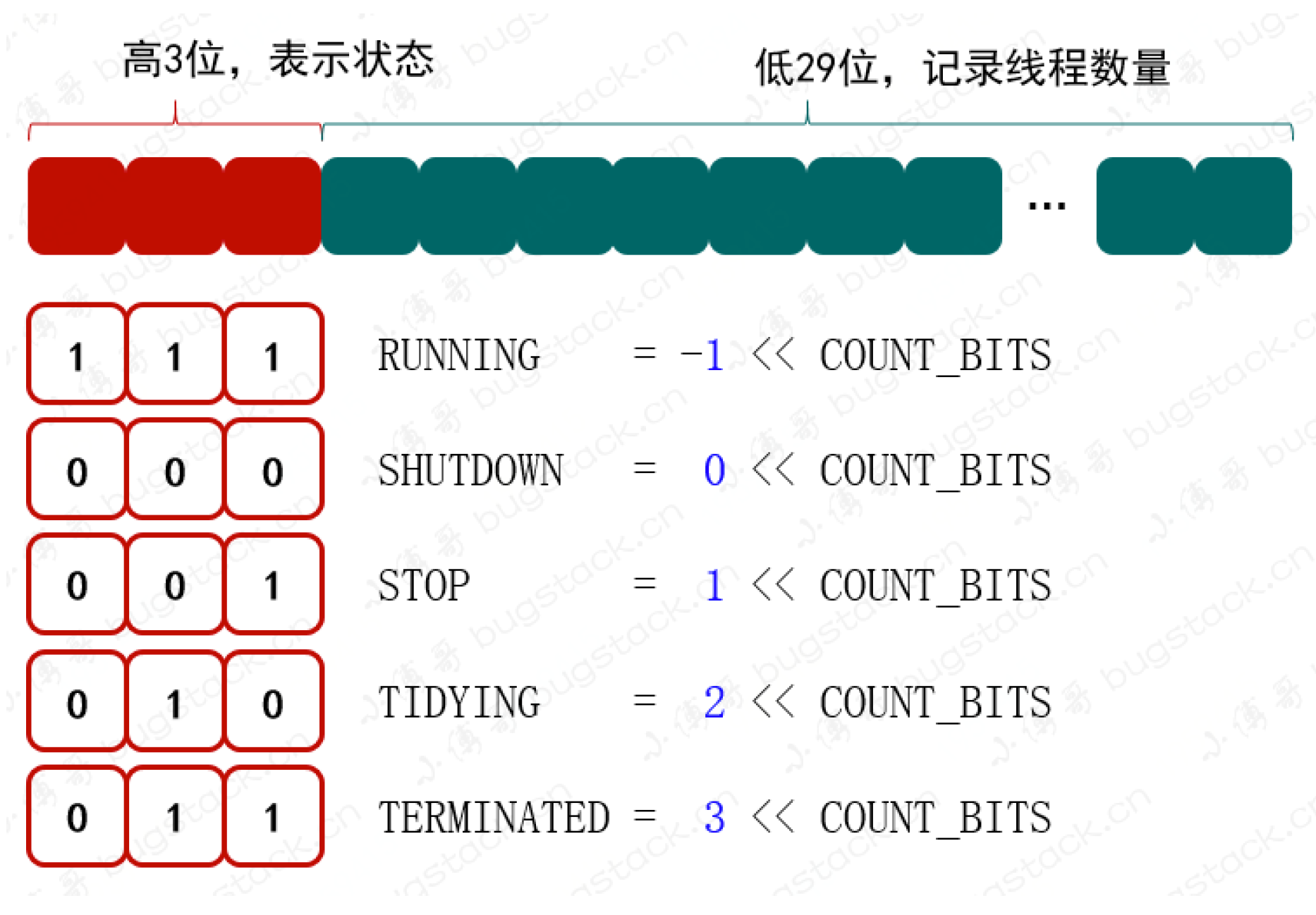
private final AtomicInteger ctl = new AtomicInteger(ctlOf(RUNNING, 0));
private static final int COUNT_BITS = Integer.SIZE - 3;
private static final int CAPACITY = (1 << COUNT_BITS) - 1;
// runState is stored in the high-order bits
private static final int RUNNING = -1 << COUNT_BITS;
private static final int SHUTDOWN = 0 << COUNT_BITS;
private static final int STOP = 1 << COUNT_BITS;
private static final int TIDYING = 2 << COUNT_BITS;
private static final int TERMINATED = 3 << COUNT_BITS;在 ThreadPoolExecutor 线程池实现类中,使用 AtomicInteger 类型的 ctl 记录线程池状态和线程池数量。在一个类型上记录多个值,它采用的分割数据区域,高 3 位记录状态,低 29 位存储线程数量,默认 RUNNING 状态,线程数为 0 个。
线程池状态

线程池中的状态流转关系,包括如下状态:
- RUNNING :运行状态,接受新的任务并且处理队列中的任务。
- SHUTDOWN :关闭状态 调用了 shutdown 方法 。不接受新任务, 但是要处理队列 中的任务。
- STOP :停止状态 调用了 shutdownNow 方法 。不接受新任务,也不处理队列中的 任务,并且要中断正在处理的任务。
- TIDYING :所有的任务都已终止了 workerCount 为 0 ,线程池进入该状态后会调 terminated() 方法进入 TERMINATED 状态。
- TERMINATED :终止状态 terminated() 方法调用结束后的状态。
提交线程(execute)
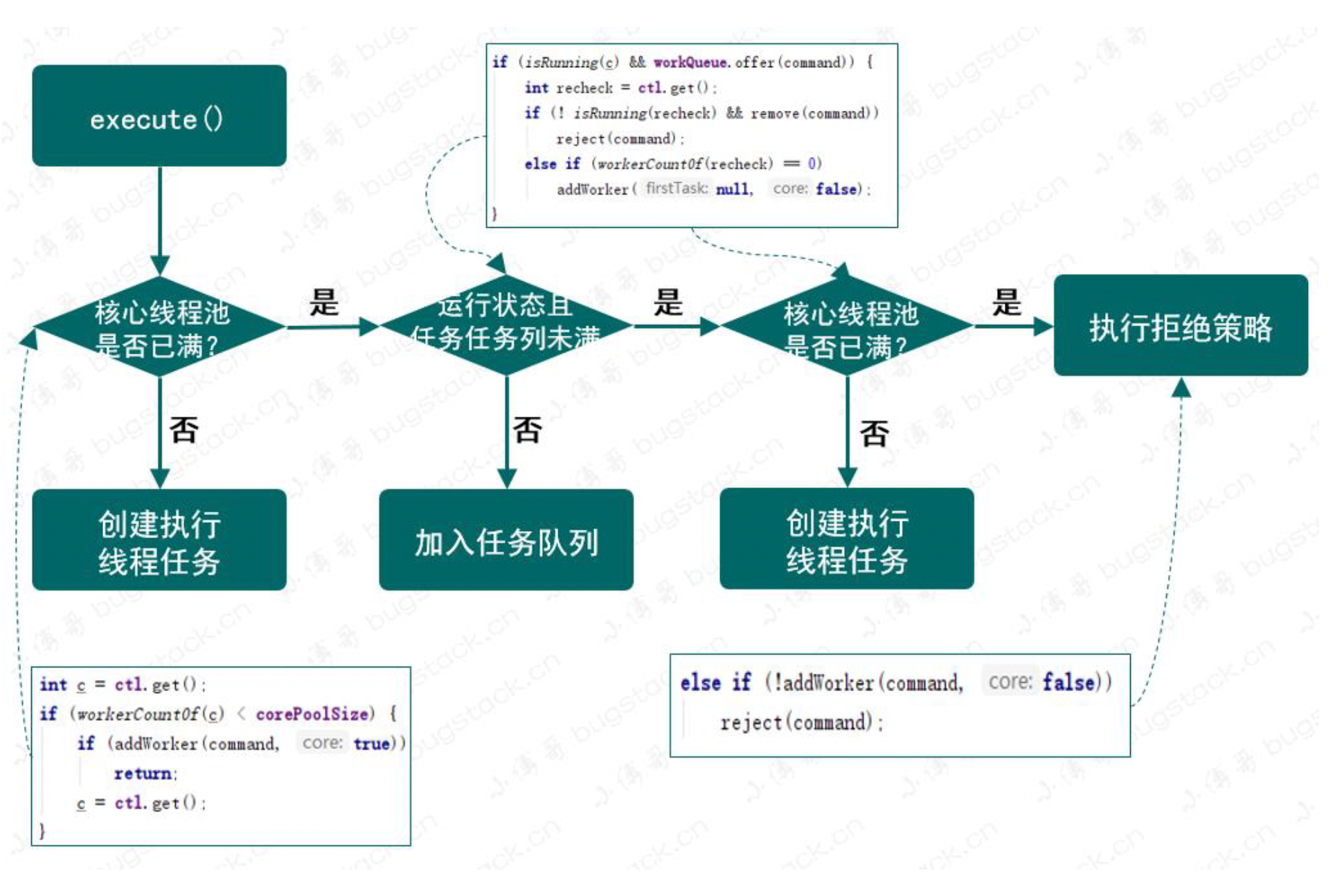
public void execute(Runnable command) {
if (command == null)
throw new NullPointerException();
/*
* Proceed in 3 steps:
*
* 1. If fewer than corePoolSize threads are running, try to
* start a new thread with the given command as its first
* task. The call to addWorker atomically checks runState and
* workerCount, and so prevents false alarms that would add
* threads when it shouldn't, by returning false.
*
* 2. If a task can be successfully queued, then we still need
* to double-check whether we should have added a thread
* (because existing ones died since last checking) or that
* the pool shut down since entry into this method. So we
* recheck state and if necessary roll back the enqueuing if
* stopped, or start a new thread if there are none.
*
* 3. If we cannot queue task, then we try to add a new
* thread. If it fails, we know we are shut down or saturated
* and so reject the task.
*/
int c = ctl.get();
if (workerCountOf(c) < corePoolSize) {
if (addWorker(command, true))
return;
c = ctl.get();
}
if (isRunning(c) && workQueue.offer(command)) {
int recheck = ctl.get();
if (! isRunning(recheck) && remove(command))
reject(command);
else if (workerCountOf(recheck) == 0)
addWorker(null, false);
}
else if (!addWorker(command, false))
reject(command);
}阅读这部分源码的时候,可以参考我们自己实现的线程池。其实最终的目的都是一样的,就是这段被提交的线程,启动执行、加入队列、决策策略,这三种方式。
- ctl.get() get(),取的是记录线程状态和线程个数的值,最终需要使用方法 workerCountOf()workerCountOf(),来获取当前线程数量。 `workerCountOf 执行的是 c & CAPACITY 运算
- 根据当前线程池中线程数量,与核心线程数 corePoolSize 做对比,小于则进 行添加线程到任务执行队列。
- 如果说此时线程数已满,那么则需要判断线程池是否为运行状态 isRunning(c) 。如果是运行状态则把不能被执行的线程放入线程队列中。
- 放入线程队列以后,还需要重新判断线程是否运行以及移除操 作,如果非运行且移 除,则进行拒绝策略。否则判断线程数量为 0 后添加新线程。
- 最后就是再次尝试添加任务执行,此时方法 addWorker 的第二个入参是 false 最终会影响添加执行任务数量判断。如果添加失败则进行拒绝策略。
添加执行任务(addWorker)
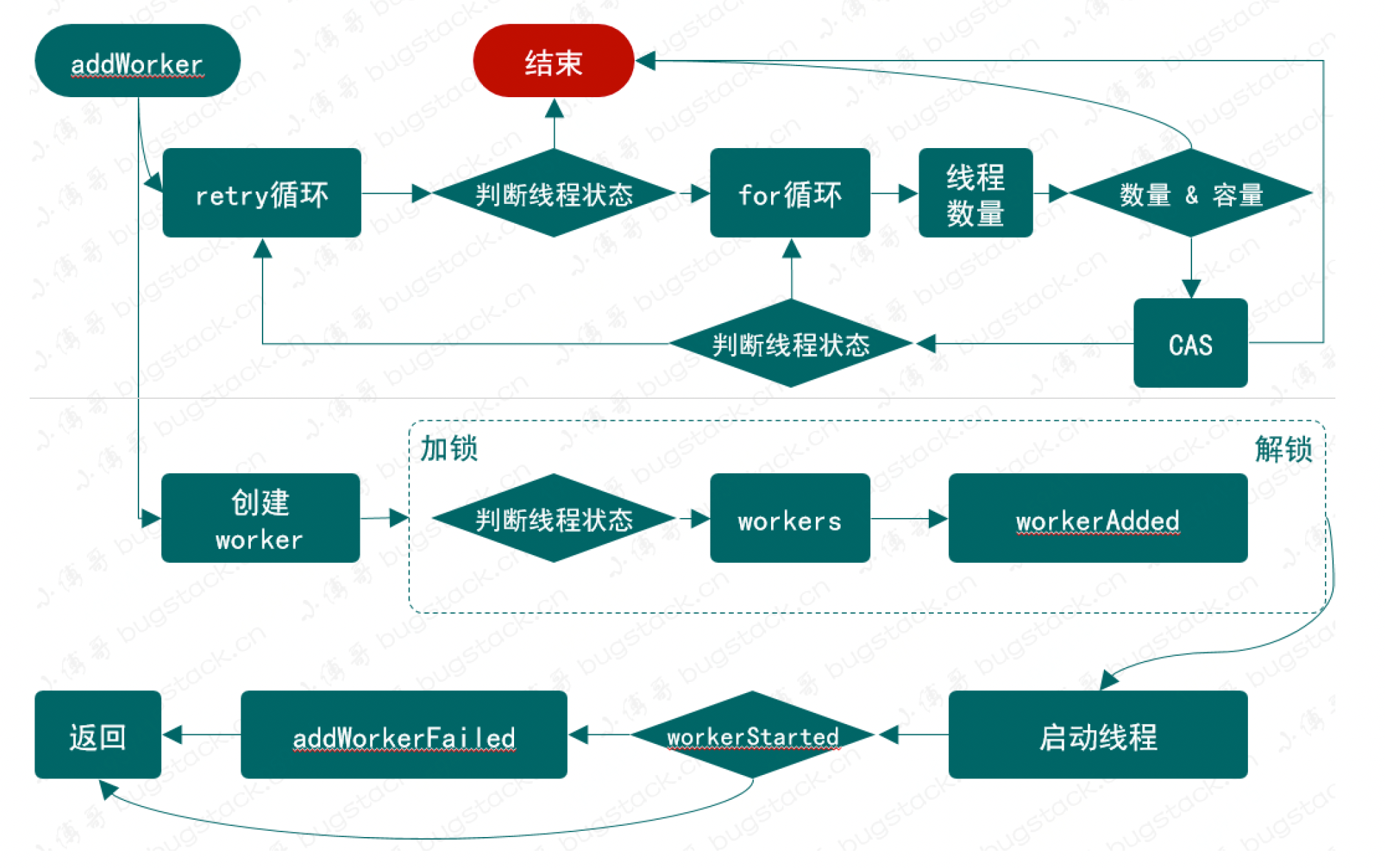
- 增加线程数量
private boolean addWorker(Runnable firstTask, boolean core) {
retry:
for (;;) {
int c = ctl.get();
int rs = runStateOf(c);
// Check if queue empty only if necessary.
if (rs >= SHUTDOWN &&
! (rs == SHUTDOWN &&
firstTask == null &&
! workQueue.isEmpty()))
return false;
for (;;) {
int wc = workerCountOf(c);
if (wc >= CAPACITY ||
wc >= (core ? corePoolSize : maximumPoolSize))
return false;
if (compareAndIncrementWorkerCount(c))
break retry;
c = ctl.get(); // Re-read ctl
if (runStateOf(c) != rs)
continue retry;
// else CAS failed due to workerCount change; retry inner loop
}
}- 创建启动线程
boolean workerStarted = false;
boolean workerAdded = false;
Worker w = null;
try {
w = new Worker(firstTask);
final Thread t = w.thread;
if (t != null) {
final ReentrantLock mainLock = this.mainLock;
mainLock.lock();
try {
// Recheck while holding lock.
// Back out on ThreadFactory failure or if
// shut down before lock acquired.
int rs = runStateOf(ctl.get());
if (rs < SHUTDOWN ||
(rs == SHUTDOWN && firstTask == null)) {
if (t.isAlive()) // precheck that t is startable
throw new IllegalThreadStateException();
workers.add(w);
int s = workers.size();
if (s > largestPoolSize)
largestPoolSize = s;
workerAdded = true;
}
} finally {
mainLock.unlock();
}
if (workerAdded) {
t.start();
workerStarted = true;
}
}
} finally {
if (! workerStarted)
addWorkerFailed(w);
}
return workerStarted;
}添加执行任务的流程可以分为两块看,上面代码部分是用于记录线程数量、下面代码部分是在独占锁里创建执行线程并启动。这部分代码在不看锁、CAS 等操作,那么就和我们最开始手写的线程池基本一样了
- if (rs >= SHUTDOWN &&! (rs == SHUTDOWN &&firstTask = == null &&! workQueue.isEmpty())) isEmpty())),判断当前线程池状态,是否为 SHUTDOWN 、 STOP 、 TIDYING 、 TERMINATED 中的一个。并且当前状态为 SHUTDOWN 、且传入的任务为 null ,同时队列不为空。那么就返回 false 。
- compareAndIncrementWorkerCount CAS 操作,增加线程数量,成功就会 跳出标记的循环体。
- runStateOf(c) != rs ,最后是线程池状态判断,决定是否循环。
- 在线程池数量记录成功后,则需要进入加锁环节,创建执行线程,并记录状态。在 最后如果判断没有启动成功,则需要执行 addWorkerFailed 方法,剔除到线程方 法等操作。
执行线程(runWorker)
final void runWorker(Worker w) {
Thread wt = Thread.currentThread();
Runnable task = w.firstTask;
w.firstTask = null;
w.unlock(); // allow interrupts
boolean completedAbruptly = true;
try {
while (task != null || (task = getTask()) != null) {
w.lock();
// If pool is stopping, ensure thread is interrupted;
// if not, ensure thread is not interrupted. This
// requires a recheck in second case to deal with
// shutdownNow race while clearing interrupt
if ((runStateAtLeast(ctl.get(), STOP) ||
(Thread.interrupted() &&
runStateAtLeast(ctl.get(), STOP))) &&
!wt.isInterrupted())
wt.interrupt();
try {
beforeExecute(wt, task);
Throwable thrown = null;
try {
task.run();
} catch (RuntimeException x) {
thrown = x; throw x;
} catch (Error x) {
thrown = x; throw x;
} catch (Throwable x) {
thrown = x; throw new Error(x);
} finally {
afterExecute(task, thrown);
}
} finally {
task = null;
w.completedTasks++;
w.unlock();
}
}
completedAbruptly = false;
} finally {
processWorkerExit(w, completedAbruptly);
}
}最核心的点就是 task.run() 让线程跑起来。额外再附带一些其他流程如下;
- beforeExecute 、 afterExecute ,线程执行的前后做一些统计信息。
- 另外这里的锁操作是 Worker 继承 AQS 自己实现的不可 重入的独占锁。
队列获取任务(getTask)
private Runnable getTask() {
boolean timedOut = false; // Did the last poll() time out?
for (;;) {
int c = ctl.get();
int rs = runStateOf(c);
// Check if queue empty only if necessary.
if (rs >= SHUTDOWN && (rs >= STOP || workQueue.isEmpty())) {
decrementWorkerCount();
return null;
}
int wc = workerCountOf(c);
// Are workers subject to culling?
boolean timed = allowCoreThreadTimeOut || wc > corePoolSize;
if ((wc > maximumPoolSize || (timed && timedOut))
&& (wc > 1 || workQueue.isEmpty())) {
if (compareAndDecrementWorkerCount(c))
return null;
continue;
}
try {
Runnable r = timed ?
workQueue.poll(keepAliveTime, TimeUnit.NANOSECONDS) :
workQueue.take();
if (r != null)
return r;
timedOut = true;
} catch (InterruptedException retry) {
timedOut = false;
}
}
}- getTask 方法从阻塞队列中获取等待被执行的任务,也就是一条条往出拿线程方 法。
- if (rs >= SHUTDOWN … …,判断线程是否关闭。
- wc = workerCountOf(c) wc > corePoolSize ,如果工作线程数超过核 心线程数量 corePoolSize 并且 workQueue 不为空,则增加工作线程。但如 果超时未获取到线程,则会把大于 corePoolSize 的线程销毁掉。
- timed ,是 allowCoreThreadTimeOut 得来的。最终 timed 为 true 时, 则通过阻塞队列的 poll 方法进行超时控制。
- 如果在 keepAliveTime 时间内没有获取到任务,则返回 null 。如果为 false 则阻塞。